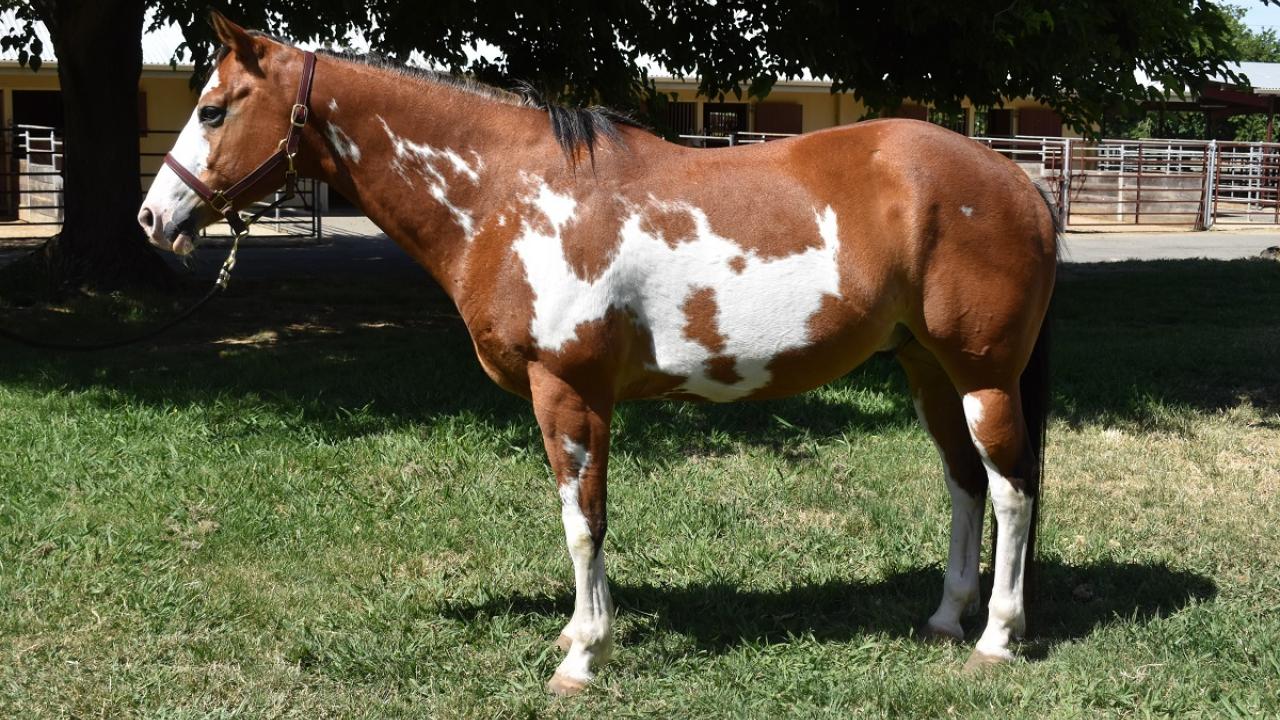
Lethal White Overo Syndrome (LWO)
Takeaways
- LWO is an autosomal recessive inherited condition primarily reported in Paint horses and closely related breeds.
- It is caused by the same mutation that causes the frame overo white spotting patterns.
- Affected foals are all white and born with an underdeveloped intestinal tract, which leads to problems defecating and eventually severe colic.
- There is no treatment for LWO and affected foals die or are humanely euthanized.
- A causative mutation for LWO has been identified and a genetic test is available to help breeders avoid producing affected foals.
What is overo lethal white foal syndrome?
Lethal white overo (LWO) syndrome, also known as ileocolonic aganglionosis or aganglionic megacolon, is an autosomal recessive inherited disease primarily reported in Paint horses. Horses with a particular white spotting pattern known as frame overo can produce affected offspring. The frame overo pattern can vary along a continuum, but most horses with this pattern have pigment that “frames the horse”, with white patterning primarily occurring on the abdomen, middle of the neck, and face. Affected foals are all white and are born with an underdeveloped intestinal tract. They cannot move food through their intestinal tract properly and cannot defecate, leading to colic.
A mutation in the endothelin receptor B (EDNRB) gene is causes LWO. A DNA test is available that will detect the mutation, or “O” allele, which in homozygotes causes LWO.
Since the frame overo white spotting pattern can vary, with some horses having very little white while others are almost completely white, it is not always obvious to tell if a horse is a frame overo just by appearance. In some cases, horses thought to be solid colored with no obvious spotting patterns have produced affected foals. In addition to Paint horses, the causative mutation has also been identified in Thoroughbreds, Quarter Horses, Appaloosas, and American Miniature Horses.
What are the clinical signs of overo lethal white foal syndrome?
Affected foals exhibit an all-white coat color with pink skin and blue eyes. They may also be deaf. Although some foals may appear normal at birth, they have trouble passing manure. Clinical signs of abdominal pain and colic are typically observed within the first 12 hours and progress rapidly. Affected foals may show typical signs of colic such as rolling or thrashing, sweating, and rapid breathing. They may also have a distended belly.
Overo patterned horses with one copy of the mutation are not affected and do not show clinical signs of the disease, but they can pass the mutation on to their offspring. They may also be deaf.
How is overo lethal white foal syndrome diagnosed?
Overo lethal white foal syndrome can be diagnosed based on the characteristic white coat color paired with the available genetic test. It is important to note that some foals are born with very light-colored pigment (such as cremellos) and other white spotting patterns, but are not affected. This can be confirmed by the DNA test.
Due to the rapid progression of the disease, diagnosis is often made postmortem by identifying abnormalities in the intestinal tract.
How is overo lethal white foal syndrome treated?
Due to the severity of the disease, there is no treatment or “cure” for OLWFS. Affected foals die within a few days of birth from bowel rupture or buildup of toxic waste material in the blood, or are humanely euthanized.
What is the prognosis for overo lethal white foal syndrome?
Affected foals do not survive. The prognosis for carriers is excellent as there are no known health problems (aside from deafness) associated with carrier status for this disease.
How can overo lethal white foal syndrome be prevented?
Breeders can prevent LWO in their horses by performing DNA testing on potential sires and dams and avoiding carrier matings. Hair samples (with the roots attached) can be submitted to the UC Davis Veterinary Genetics Laboratory. Offspring of two LWO carriers have a 25% chance of being affected. Breeding an unaffected horse to a carrier will not result in an affected foal but will produce an LWO carrier foal 50% of the time.
The American Paint Horse Association requires the LWO genetic test for breeding stallions prior to the registration of any offspring.
For more information:
UC Davis Veterinary Genetics Laboratory LWO DNA testing
*This article may not be reproduced without the written consent of the UC Davis Center for Equine Health. Please email requests to cehadmin@ucdavis.edu.
